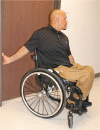A Primary Care Provider's Guide to Shoulder Pain After Spinal Cord Injury
- PMID: 33192046
- PMCID: PMC7640906
- DOI: 10.46292/sci2603-186
A Primary Care Provider's Guide to Shoulder Pain After Spinal Cord Injury
Abstract
Shoulder pain is a common occurrence after spinal cord injury (SCI) and can have significant negative effects on health and function as many individuals with SCI are reliant on their upper extremities for mobility and self-care activities. Shoulder pain after SCI can be caused by acute injury or chronic pathology, but it is most often related to overuse injuries of the rotator cuff. Both acute strain and chronic overuse shoulder injuries in persons with SCI typically result from increased weight bearing on the upper extremities during transfers, weight-relief raises, and wheelchair propulsion, which are often performed in poor postural alignment owing to strength deficits. This article discusses management of patients with SCI who present with shoulder pain from the perspective of primary care physicians including evaluation and diagnostic procedures, interventions appropriate for both acute and chronic shoulder pain, and strategies for prevention.
Keywords: rehabilitation; rotator cuff; shoulder pain; spinal cord injury.
© 2020 American Spinal Injury Association.
Conflict of interest statement
The authors report no conflicts of interest.
Figures







Similar articles
-
Models of care for musculoskeletal shoulder pain in spinal cord injury: A scoping review.J Spinal Cord Med. 2024 May;47(3):327-344. doi: 10.1080/10790268.2023.2183335. Epub 2023 Mar 13. J Spinal Cord Med. 2024. PMID: 36913538 Free PMC article.
-
Upper Extremity Overuse Injuries and Obesity After Spinal Cord Injury.Top Spinal Cord Inj Rehabil. 2021;27(1):68-74. doi: 10.46292/sci20-00061. Top Spinal Cord Inj Rehabil. 2021. PMID: 33814884 Free PMC article. Review.
-
Risk factors for shoulder pain in patients with spinal cord injury: a multicenter study.Musculoskelet Surg. 2015 Sep;99 Suppl 1:S53-6. doi: 10.1007/s12306-015-0363-2. Epub 2015 May 23. Musculoskelet Surg. 2015. PMID: 26002597
-
Shoulder ultrasound abnormalities, physical examination findings, and pain in manual wheelchair users with spinal cord injury.Arch Phys Med Rehabil. 2008 Nov;89(11):2086-93. doi: 10.1016/j.apmr.2008.05.015. Arch Phys Med Rehabil. 2008. PMID: 18996236
-
Autologous, micro-fragmented adipose tissue as a treatment for chronic shoulder pain in a wheelchair using individual with spinal cord injury: a case report.Spinal Cord Ser Cases. 2019 May 13;5:46. doi: 10.1038/s41394-019-0186-8. eCollection 2019. Spinal Cord Ser Cases. 2019. PMID: 31632705 Free PMC article.
Cited by
-
Upper limb muscle strength and wheelchair-related abilities following an exoskeleton-assisted walking programme in individuals with chronic spinal cord injury: An exploratory study.J Rehabil Med. 2024 Nov 21;56:jrm19461. doi: 10.2340/jrm.v56.19461. J Rehabil Med. 2024. PMID: 39570107 Free PMC article.
-
Models of care for musculoskeletal shoulder pain in spinal cord injury: A scoping review.J Spinal Cord Med. 2024 May;47(3):327-344. doi: 10.1080/10790268.2023.2183335. Epub 2023 Mar 13. J Spinal Cord Med. 2024. PMID: 36913538 Free PMC article.
-
Network analysis of multimorbidity and health outcomes among persons with spinal cord injury in Canada.Front Neurol. 2024 Jan 5;14:1286143. doi: 10.3389/fneur.2023.1286143. eCollection 2023. Front Neurol. 2024. PMID: 38249735 Free PMC article.
-
Upper Extremity Overuse Injuries and Obesity After Spinal Cord Injury.Top Spinal Cord Inj Rehabil. 2021;27(1):68-74. doi: 10.46292/sci20-00061. Top Spinal Cord Inj Rehabil. 2021. PMID: 33814884 Free PMC article. Review.
-
Progression of rotator cuff tendon pathology in manual wheelchair users with spinal cord injury: A 1-year longitudinal study.J Spinal Cord Med. 2023 May;46(3):466-476. doi: 10.1080/10790268.2022.2057720. Epub 2022 Apr 14. J Spinal Cord Med. 2023. PMID: 35420535 Free PMC article.
References
MeSH terms
LinkOut - more resources
Full Text Sources
Medical
